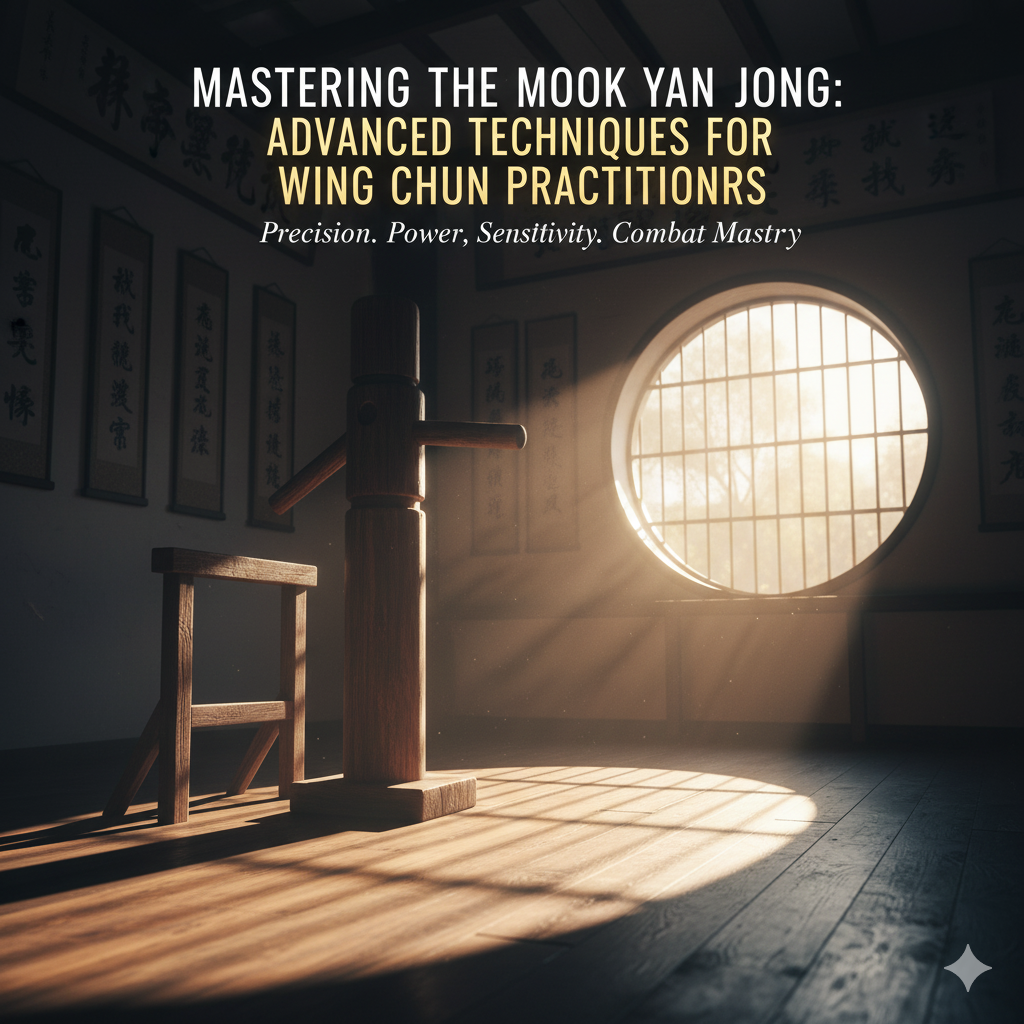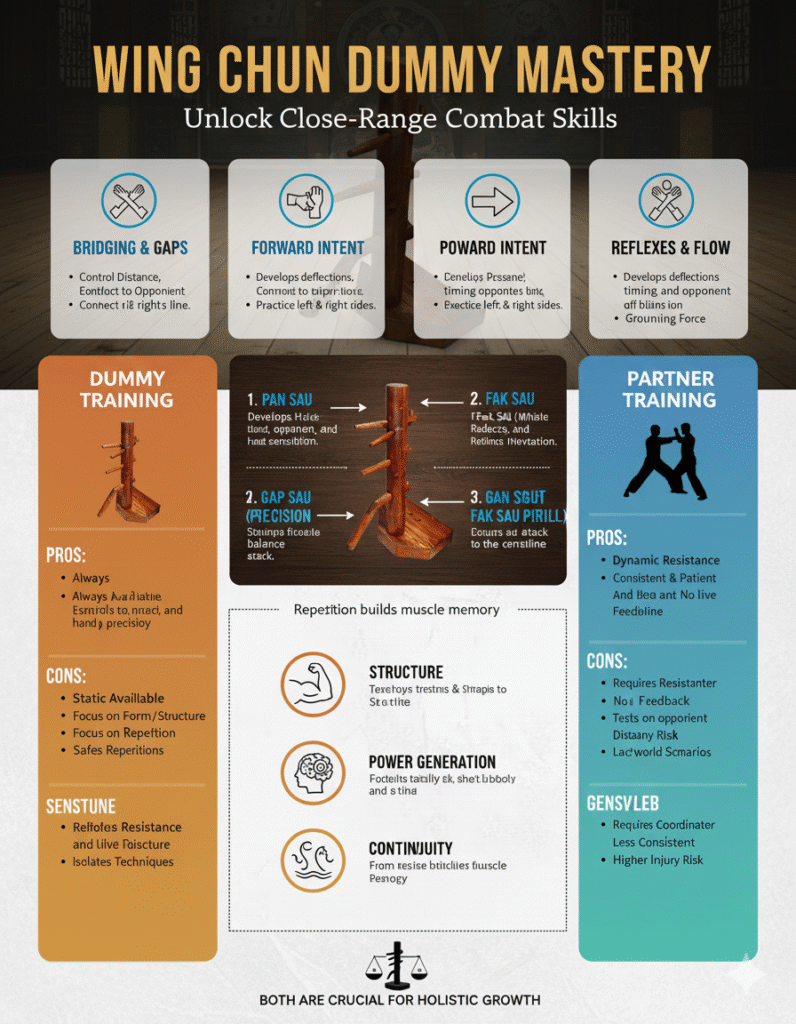The Mook Yan Jong, or Wooden Dummy, stands as an iconic and indispensable training tool within the Wing Chun martial art system.
Far beyond a mere static object, it serves as a dynamic partner, helping practitioners refine their techniques, develop crucial attributes, and internalize the principles of Wing Chun.
While foundational drills are essential, true mastery emerges from delving into advanced Mook Yan Jong techniques and understanding their practical applications.

The Evolution of Training: Beyond the Basics
For many, the journey with the Mook Yan Jong begins with learning the classical 108-movement form.
However, this form is merely a framework. Advanced training transcends rote memorization, focusing instead on the underlying principles and the nuanced development of sensitivity, timing, and power.
It’s about transforming mechanical movements into fluid, adaptive responses applicable in live situations.
Advanced Techniques for Unparalleled Skill Development
Advanced Mook Yan Jong training introduces a series of sophisticated drills designed to push the boundaries of a practitioner’s skill set.
These techniques are not about adding complexity for its own sake, but about cultivating a deeper understanding of Wing Chun’s core concepts:
One-Arm Wooden Dummy Training Series: This foundational advanced series focuses on developing core coordination and pressure awareness.
By isolating one arm, practitioners enhance their ability to control and manipulate an opponent’s limb while maintaining their own structure and balance [1].

Two-Arm Structural Flow and Sensitivity Drills:
Building upon single-arm control, these drills train integrated contact response.
They emphasize the seamless transition between offensive and defensive actions, fostering a heightened sense of sensitivity to an opponent’s force and direction [1].
The Complete Wooden Dummy Form: While learned early, the “complete wooden dummy form” is continuously refined at advanced levels.
It’s a layered sequence that encodes intricate footwork, precise timing, and effective bridging strategies into every movement, offering endless opportunities for deeper understanding and application [1].
Specialized Combat Drills: Advanced practitioners engage in specific combinations that simulate real combat scenarios.
Examples include:
Pock, Tan Da: A sequence involving a slapping block followed by a palm-up block and a punch, emphasizing simultaneous defense and offense [2].
Jom, Gnoy Jut Da Fun Sau: A combination that intercepts and strikes simultaneously, highlighting the efficiency of Wing Chun’s direct approach [2].
Boang, Tan Da: Utilizes a wing arm block followed by a palm-up block and punch, focusing on deflecting incoming force and immediately counter-attacking [2].
Fook, Woo Da Chahng Dai Jyeung: Incorporates a hooking hand with a simultaneous block and strike, demonstrating advanced limb control and targeting [2].

Integrating Low-Line Kicks: To further enhance realism and combat readiness, advanced drills often incorporate low-line kicks into the combinations.
This adds another dimension to the training, preparing practitioners for a wider range of self-defense situations [2].
Applications in Real-World Scenarios
The true value of advanced Mook Yan Jong techniques lies in their direct applicability to real-world combat and self-defense.
These drills are not just physical exercises; they are mental blueprints for effective engagement:
Enhanced Coordination and Timing: The fluid, continuous nature of advanced dummy work significantly improves a practitioner’s ability to coordinate multiple actions (blocking, striking, stepping) with precise timing, crucial for effective self-defense.
Developing Sensitivity (Chi Sao): The constant contact with the dummy’s limbs hones tactile sensitivity, a key component of Wing Chun’s “sticky hands” (Chi Sao) practice.
This allows practitioners to feel and respond to an opponent’s intentions and movements almost instinctively.
Structural Integrity and Power Generation:
Advanced drills reinforce proper body mechanics, ensuring that power is generated from the ground up and channeled efficiently through the body into strikes.
This develops formidable structural integrity, making a practitioner difficult to unbalance.
Ambidexterity and Spatial Memory: Consistent practice on both sides of the dummy fosters ambidexterity and sharpens spatial awareness, enabling practitioners to react effectively regardless of the angle of attack or their own positioning.
Rapid Reaction Skills: The dynamic nature of advanced Mook Yan Jong training cultivates rapid reaction skills, allowing for instantaneous responses to unexpected movements and attacks.
Conclusion
Advanced Mook Yan Jong techniques are a testament to the depth and sophistication of Wing Chun.
They offer a pathway for dedicated practitioners to transcend basic movements and cultivate a profound understanding of martial principles.
By embracing these advanced drills, one can unlock new levels of precision, power, and sensitivity, ultimately leading to a more complete and effective martial artist.
The journey with the Wooden Dummy is continuous, always offering new insights and challenges for those committed to mastering the art.
References:
[1] The Art of Mook Yan Jong. (n.d.). *Wing Chun Wooden Dummy Training with Mook Yan Jong*. Retrieved from []()




